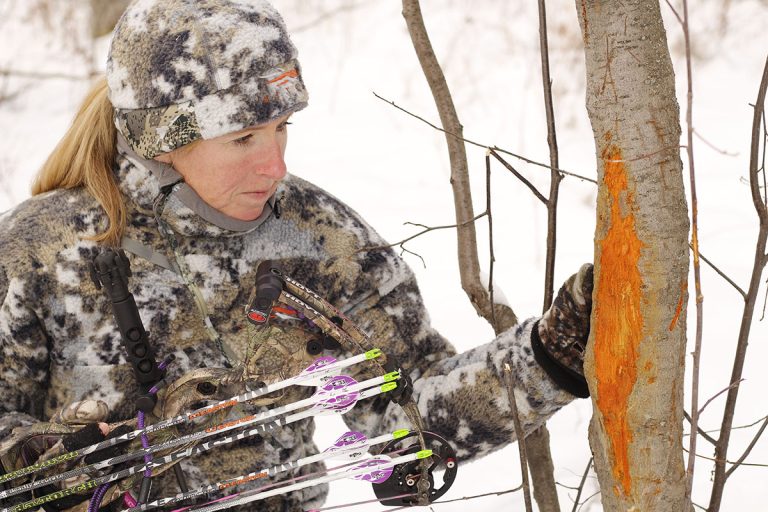Its 6:00 am as I pull up to my chosen hunting spot for the day. It snowed overnight, and the temperature is minus 10 degrees Celsius – not too cold if you’re moving, but sitting motionless is another story. My usual 30-minute walk is now 40 with the fresh snow. I get out of the vehicle and methodically go through everything I’ll need for my full day sit. Careful consideration went into filling my backpack the previous evening. Multiple hand and toe warmers, extra batteries for my heated vest, extra toque, mitts, rangefinder, doe bleat, grunt tube, rattling antlers, doe estrus and scrape starter scents, a few snacks, plus video camera and accessories. I quickly spray down with scent eliminator, grab my bow with quiver attached and make one last mental check. Yup, got everything. Release in hand, I gently close the door, and I head off into the pre-dawn darkness.
Cold Weather Challenges
Everything is more difficult, and takes longer, in the cold and snow. Multiple layers of clothing and the added strain of walking through deep snow make it awkward to move. One key to cold-weather hunting is to ensure that you don’t overheat on route to the stand as this will cause you to sweat and, ultimately get chilled. Frequent breaks allowing your body to cool down, periodic pauses are a must. This is where the importance of a good wicking base layer comes into play. I recommend Merino wool as it is warm, and wicks moisture away from your body. It also dries quickly if you sweat thus keeping you warm and dry. I personally have a couple different base layer weights that I interchange depending on the forecast and need for added warmth.
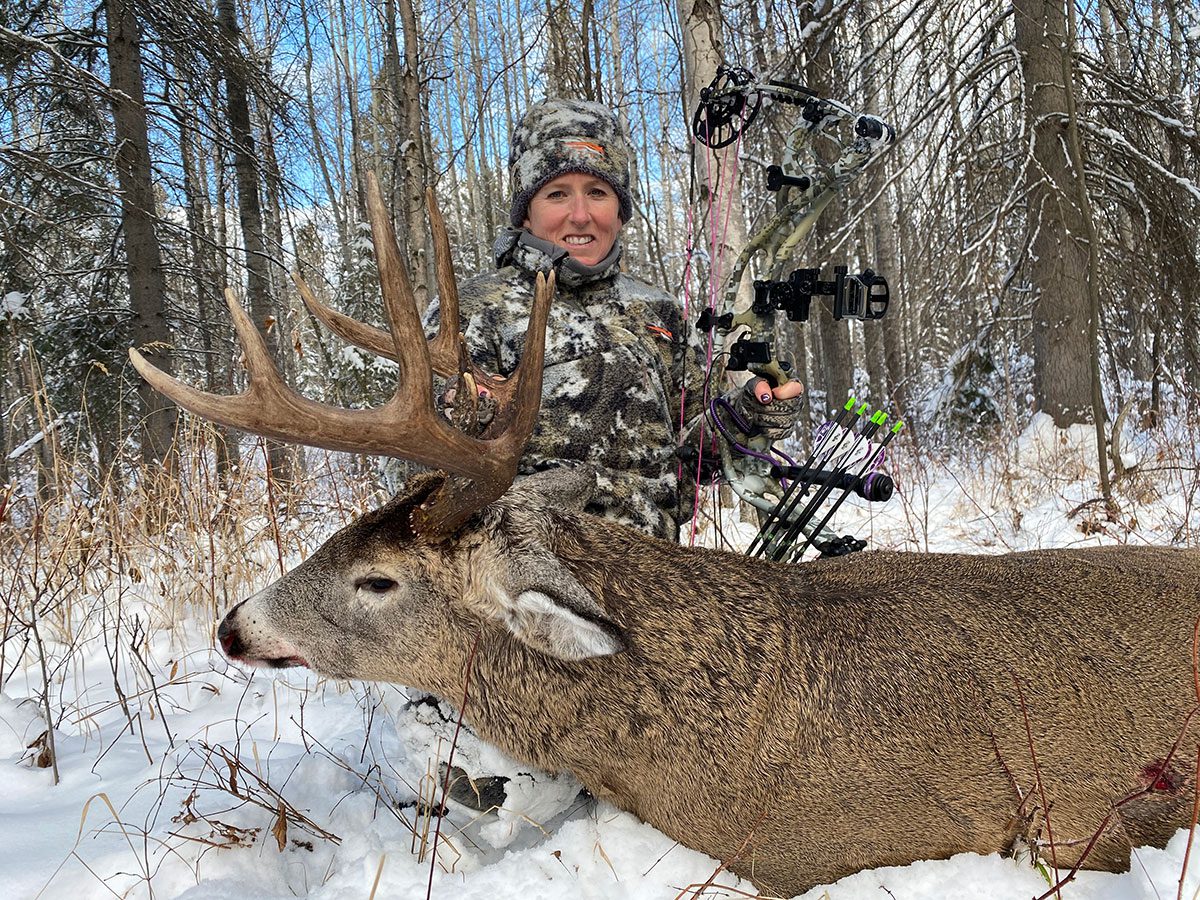
Experimentation & Solutions
Growing up in Alberta, meant learning to thrive where six months of the year a blanket of white commonly covers the landscape. Hunting, but more specifically whitetail hunting, with a bow, in temperatures that run from plus 10 to minus 30, was inevitable. With over 20 years of experimentation, as well as the advancements and availability of women’s hunting apparel, figuring out a cold-weather clothing system that allows me to remain on stand all day, has greatly improved my comfort and success in the field. Indeed, I’ve discovered what I feel is the best combination of clothing layers that work, and I’m confident they’ll help you too.
The November whitetail rut in Alberta is undoubtedly my favorite. That said, it also requires the most thought, preparation, and versatility because of the potential temperature swings and long sits on stand. Over the years, I’ve tried many different layering systems. The trick to being warm is layers and heated hunting clothes. Four years ago, my husband and I were asked to participate in a hunting TV show called Bowzone Live where we would self film our day-to-day November bowhunting with the ultimate challenge being to get the kill shot on camera. This entailed full day sits, in all kinds of weather conditions. I definitely put my gear to the test and I’m pleased to say that extreme cold, wind, snow and high humidity days – although not my favorite – are manageable thanks to clothing that fits and works well.
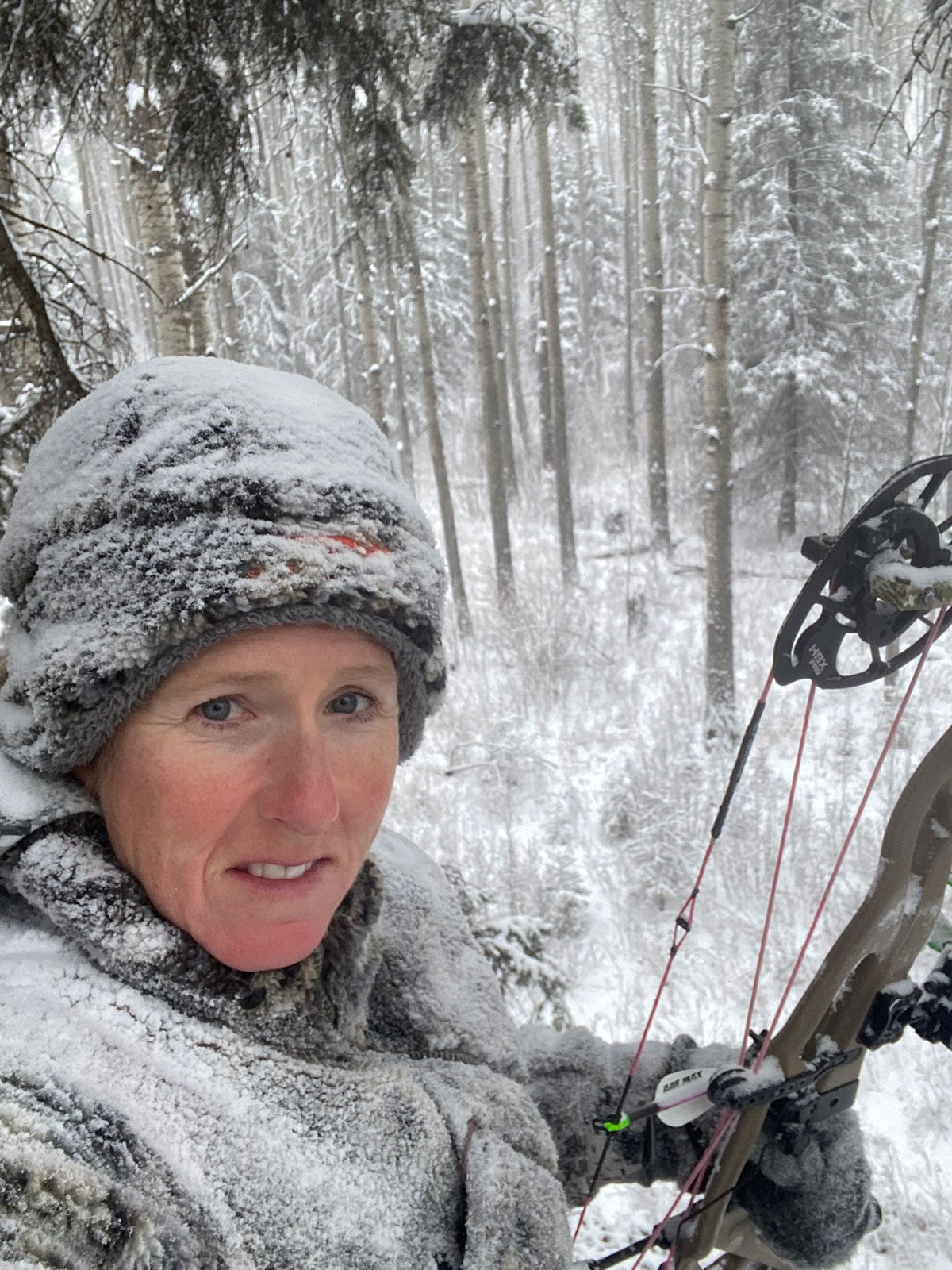
Women’s Apparel Needs
It’s no secret, women get cold faster than men. We like to be warm, and our curves generally don’t fit men’s clothing. I am very pleased to say that apparel for women has evolved leaps and bounds in the past decade. Thanks to significant technological advancements, cold-weather is very manageable and it becomes little more than a speed bump on the road to success. Seriously ladies, cold-weather solutions are out there, you just need to find the ones that work best for you. The most important qualities that I personally want in my cold weather gear is flexibility, fit (not too tight or too bulky), warmth, and quiet. Each of these qualities have a huge bearing on my success as a hunter.
Flexibility is a must. Without freedom of movement getting in and out of stands can be a real safety issue. The ability to step up or down and twist or bend around branches and reach the ultimate goal of safely standing on a small metal lock on stand 15-20 feet up a tree is essential.
Fit speaks to comfort, too tight might prevent you from being able to draw your bow properly or do a prolonged hold at full draw as it can cause bunching in the elbow area changing your draw/ anchor point. Too bulky can also get in the way of drawing/ anchoring, or get caught in the string.
Warmth goes without saying. However, there is a distinct balancing act between being warm but not layered so bulky or tight that you are no longer flexible.
Quiet is what allows you to go undetected by the prey you are hunting, and believe me, everything is more amplified the lower the temperature drops. Wear the wrong stuff and just the movement of drawing your bow could be enough to alert a deer 20 yards or more away.
Base Layers
Merino Wool is a natural performance fiber that’s light weight, resists odour, helps regulate body temperature and wicks moisture away from the skin leaving you warm and dry. They’re available in different weights, so you can choose one that best suits the conditions you’ll be hunting in. Depending on the temperature, I personally use two weights. The first set is a mid-weight made by Ice Breaker. It includes the Women’s Merino 200 Oasis Thermal Leggings and the Merino 200 Oasis Long Sleeve Crewe Thermal Top. These are ideal for more mild days, as they wick moisture walking to and from the stand. For cold days, I really like the Sitka Women’s Core Merino 330 leggings and Half-zip Top. I find it to be perfect for warmth, but thin enough to decrease bulk.
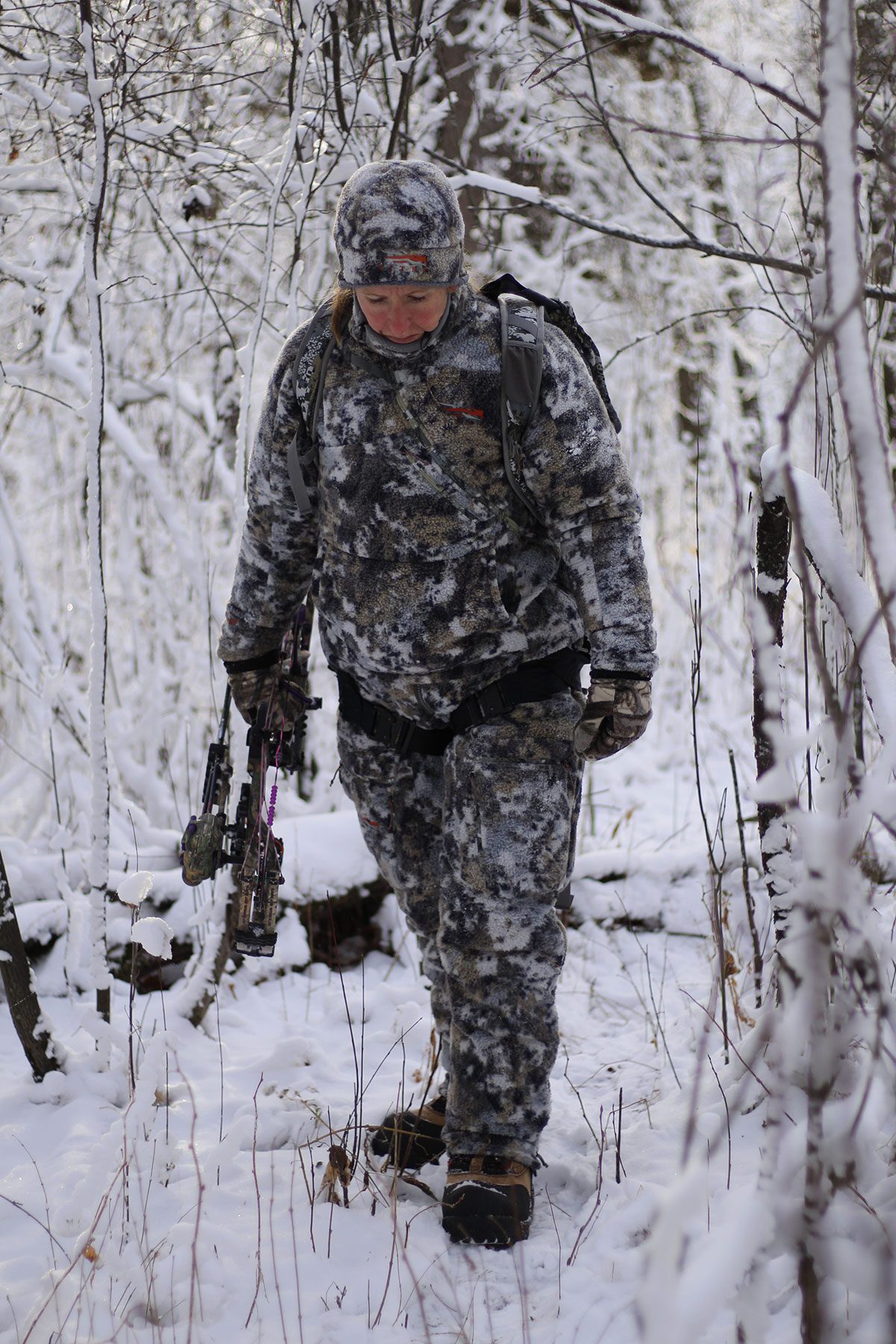
Mid-Layers/Insulation
For mid-layers, my goal is to maximize warmth while minimizing required layers and bulk. Essentially, layers can’t be restrictive. They need to be comfortable and allow flexibility and movement. If they’re too tight, this can have a reverse affect by both restricting airflow and body movement.
On Top
My mid-layer starts with the Sitka Women’s Fanatic Hoody, a heavy weight fleece insulated hoody that fits easily over my base layer. It’s incredibly warm, comfortable, and flexible so it doesn’t impede movement. While I wear it throughout the season, it’s an integral part of my cold weather gear.
Next, I love my Women’s Celsius Jacket. I wear this jacket from late fall to the end of the season. It fits well, has just the right amount of insulation built in to offer warmth and again, has limited bulk, especially on the arms. It compliments the rest of the system well. I’ve had this jacket for a number of years, and I’d recommend it or an equivalent any day.
Finally, for extreme cold, I can’t say enough about heated vests. This layer can mean the difference between sitting for a few hours and sitting all day. A couple years ago my husband bought me a battery-heated vest for Christmas, and I can tell you it’s a game changer. The warmth that radiates up your back and across your chest takes the edge off and is amazing. Having sat many a day in minus 15 to minus 25 degrees Celsius, the heated vest is an essential part of the system. Keep in mind though, that this is only an option when batteries can be re-charged each evening. Prior to having a heated vest, strategically placed disposable body warmer adhesives over the kidneys and on the back of the neck were a temporary solution.
Bottom Essentials
For really cold days, my go-to insulating layer for my legs is the Helly Hansen Mid-layer Pile Pant. Although my outer layer is very warm, adding this layer provides the extra warmth needed to buffer extreme cold on those long days.
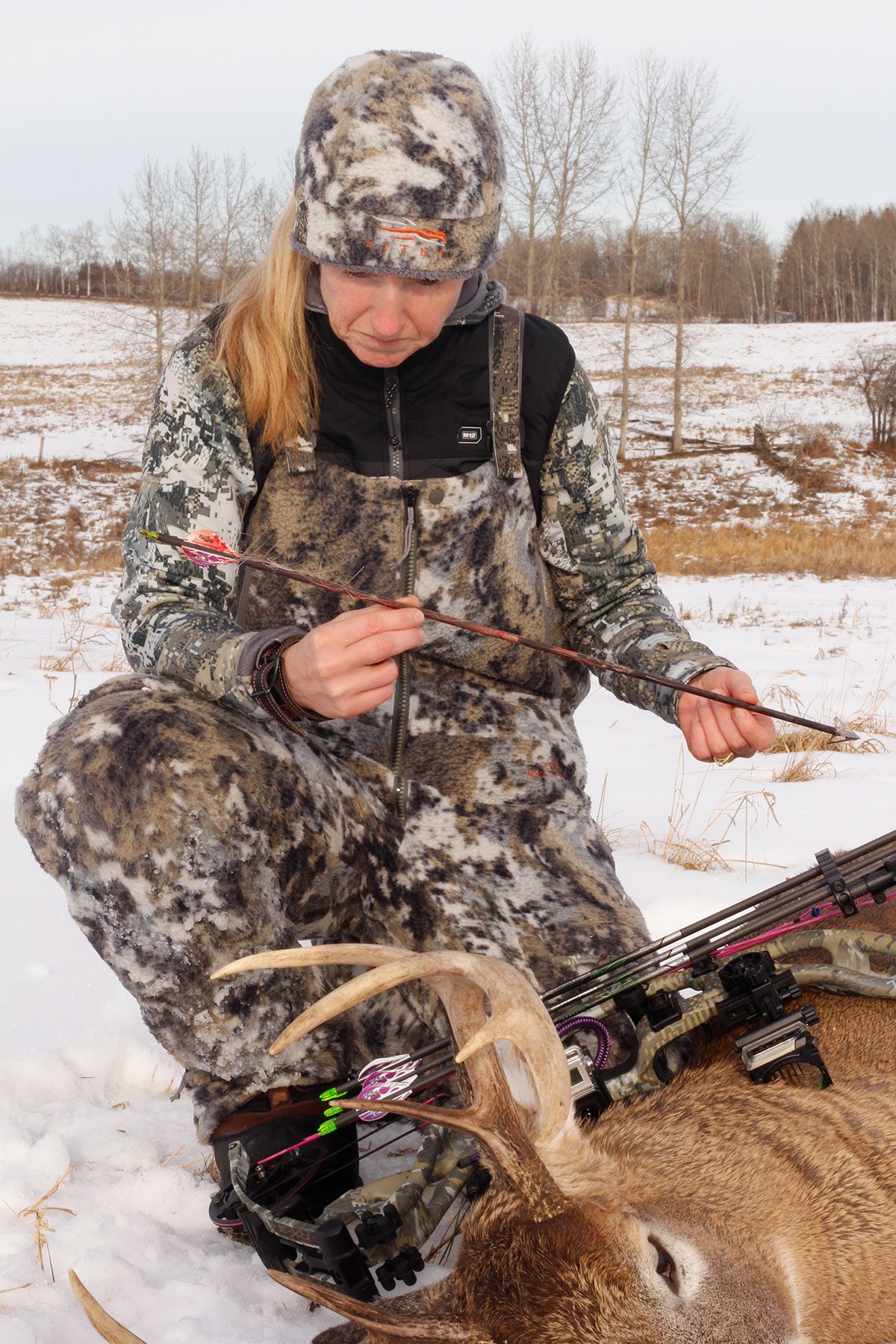

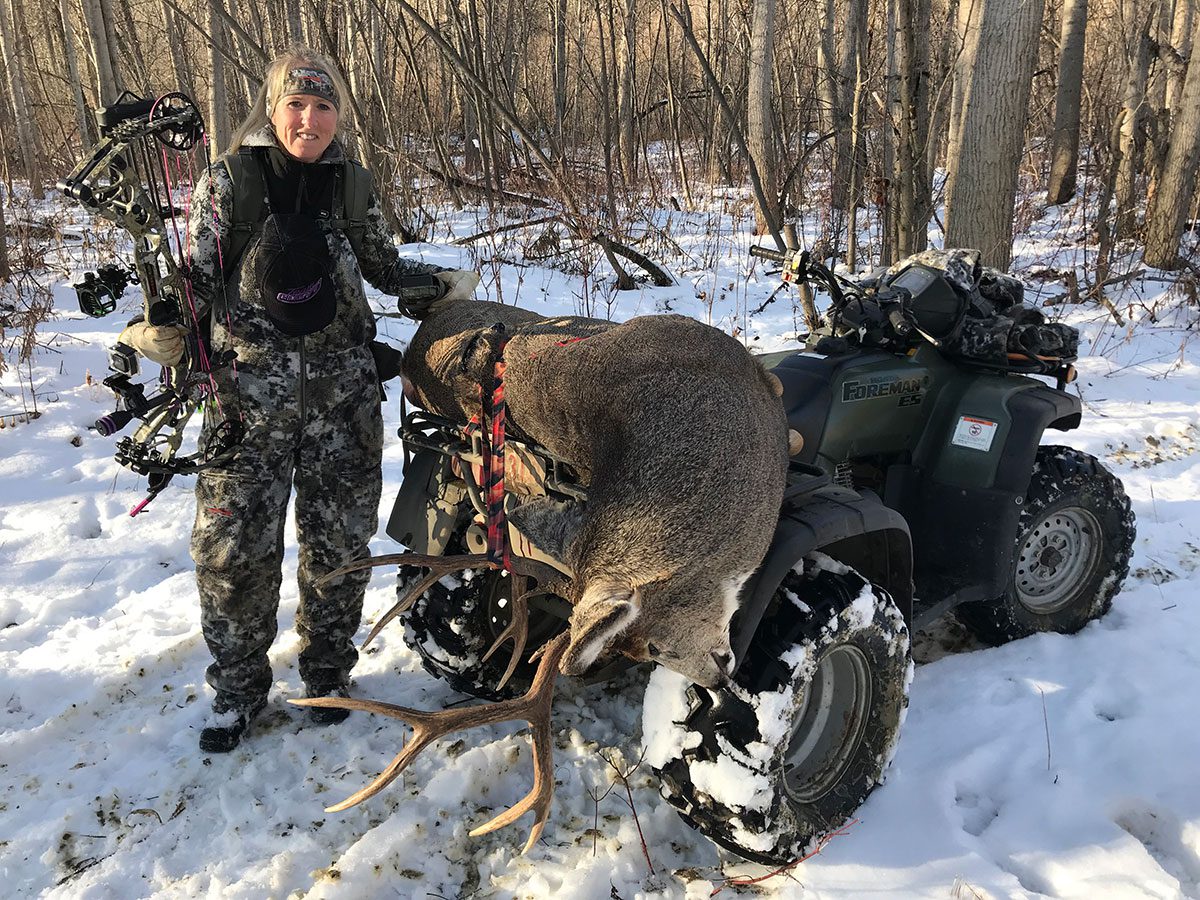
Outer Layers
I wouldn’t be overstating it if I said my choice in outer layer has been an absolute game changer. The Sitka Women’s Fanatic Line, jacket, bibs, and beanie were designed by women for women. Made with a quiet high loft Berber fleece face and ultra-quiet WINDSTOPPER by Gore-Tex labs, these are simply unbelievable! Here’s why. Sitka designed them with strategically placed insulation in places like the seat of the bibs, to prevent connective heat loss. They were designed specifically for bowhunting, so they aren’t bulky, especially in the draw arm, and they’re made to optimize draw cycle for bowstring clearance. The jacket also has a safety harness port which means that you don’t have to disconnect your harness from its anchor when putting on, or removing layers. Having tried numerous outfits over the years, I can tell you this system is by far the warmest, most functional, most comfortable, and most quiet system that I’ve worn. Bottom line – this system is designed to block the piercing cold wind, falling snow and frigid temperatures encountered on long sits on stand.
Keeping Your Feet Happy
Wool socks are a must. In fact, I usually wear one thinner pair followed by a thick, soft pair over them. The trick for me is to make sure that I have a wicking layer in case I need to hike a bit and don’t want my feet to sweat and then become wet and cold. I also make sure that my socks are not too tight in my boots. Be aware though, too much dead space in your boots can work against you as well. My boots of choice are Cabela’s Trans-Alaska Insulated Waterproof Pac Boots, they are men’s boots. With an average height of 15-inches and weighing in at just under six pounds per pair, these boots are designed to protect your feet from the elements out and your feet dry and comfortable. Three-inch soles help create a cold blocking barrier between your feet and the surface below. Removeable felt liners not only help keep my feet warm but allow me to air them out after each use. There are built in heat pack pockets in the toes, but I prefer to use the adhesive toes warmers and stick them to the bottom of my socks when required. Heated socks are also an option, but my experience is limited, and I have not found any that work well enough to recommend.
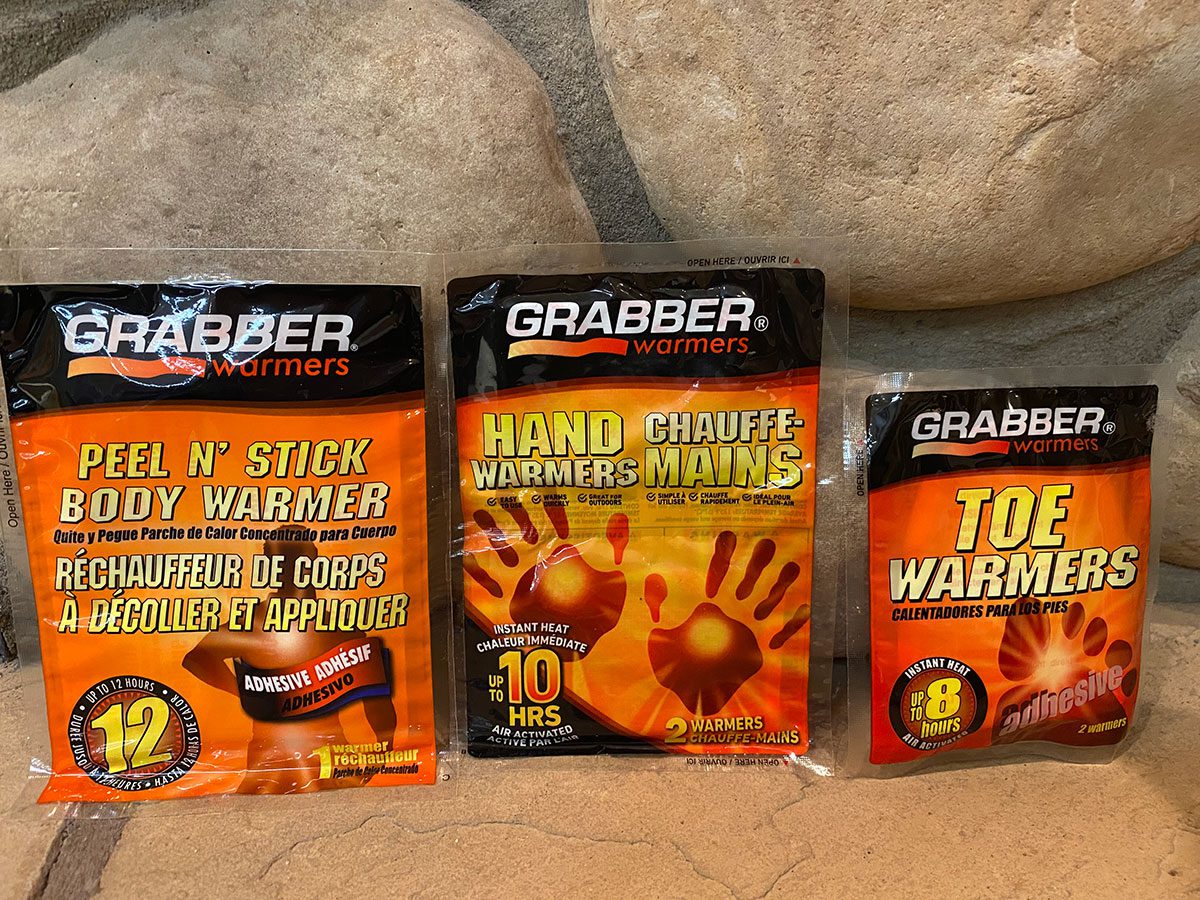
Neck and Hands
The right neck gaiter will block wind and protect your neck and lower face from the cold and wind. When I’m bowhunting however, I’ve learned that the Sitka neck gaiter with the Fanatic jacket is a bit too bulky around my chin and neck, to be able to anchor and shoot – mostly because it changes my arrow flight. In turn, I often choose not to wear it. When I’m hunting, even with just the Fanatic jacket itself, I tuck the right side of my collar in to decrease any risk of altering my anchor point.
Keeping your hands warm can be difficult, but it’s important. My choice for bowhunting in the cold, is again the Fanatic glove. They are thin enough to wear under an outer layer, but the thumb and index fingers are exposed. This allows me to have bare finger contact with my release trigger. On my bow hand I wear a second layer which is basically a generic fleece that’s also fingerless with a flip cover for the fingers.
Disposable hand warmers are a staple for sure, and I also use a rechargeable hand warmer for my release hand. Made by OCOOPA, mine has three heat settings.
Important Note
No matter what clothing system you wear, especially for archers, it’s very important to practice shooting regularly while wearing it. Extra bulk can affect your draw angle and anchor points changing your arrow flight.
Per our affiliate disclosure, we may earn revenue from the products available on this page. To learn more about how we test gear, click here.





